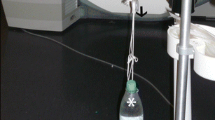Abstract
Introduction
To establish normative values of tendon to bone distances (TBDs) to evaluate the A2 and A4 annular pulley integrity, we hypothesized that these values correlate with gender, athletic exercise, occupation, individual’s age and body height.
Methods
Ultrasonography of 200 healthy individuals was performed prospectively. TBDs for the A2 and A4 pulley sections were measured for all fingers. Evaluation was performed in resting position and active forced flexion. Examination parameters included gender, age, body height, occupation, athletic exercise level, and hand dominance. Assessment of resting position and active forced flexion was done.
Results
No clinically relevant differences of TBDs with respect to the aforementioned parameters were observed. But TBDs were significantly greater in active forced flexion than in resting position for all measured pulley sections. Intraobserver reliability was very satisfactory.
Conclusions
Establishing normative values will help to detect injured pulleys more precisely and examination should be performed both in resting position and active forced flexion.






Similar content being viewed by others
References
Peterson WW, Manske PR, Bollinger BA et al (1986) Effect of pulley excision on flexor tendon biomechanics. J Orthop Res 4(1):96–101. doi:10.1002/jor.1100040112
Bowers WH, Kuzma GR, Bynum DK (1994) Closed traumatic rupture of finger flexor pulleys. J Hand Surg Am 19(5):782–787. doi:10.1016/0363-5023(94)90183-X
Gabl M, Rangger C, Lutz M et al (1998) Disruption of the finger flexor pulley system in elite rock climbers. Am J Sports Med 26(5):651–655
Schöffl VR, Einwag F, Strecker W et al (2006) Strength measurement and clinical outcome after pulley ruptures in climbers. Med Sci Sports Exerc 38(4):637–643. doi:10.1249/01.mss.0000210199.87328.6a
Arora R, Lutz M, Haug L et al (2013) Secondary reconstruction of the digital A2-flexor pulley. Oper Orthop Traumatol 25(5):499–504. doi:10.1007/s00064-011-0053-7
Barton NJ (1969) Experimental study of optimal location of flexor tendon pulleys. Plast Reconstr Surg 43(2):125–129
Lin GT, Amadio PC, An KN et al (1989) Functional anatomy of the human digital flexor pulley system. J Hand Surg Am 14(6):949–956
Van Demark RE, Kimber KA, Jorgensen BD (2014) A4 annular flexor pulley injury in a baseball pitcher. J Hand Surg Eur. doi:10.1177/1753193413518700
Vandeputte G, Dubert T (2001) Closed traumatic rupture of the flexor pulleys of a long finger associated with avulsion of the flexor digitorum superficialis. J Hand Surg Eur 26(3):266–268. doi:10.1054/jhsb.2001.0559
Doyle JR (1988) Anatomy of the finger flexor tendon sheath and pulley system. J Hand Surg Am 13(4):473–484
Doyle JR (1989) Anatomy of the flexor tendon sheath and pulley system: a current review. J Hand Surg Am 14(2 Pt 2):349–351
Leeflang S, Coert JH (2014) The role of proximal pulleys in preventing tendon bowstringing: pulley rupture and tendon bowstringing. J Plast Reconstr Aesthet Surg 67(6):822–827. doi:10.1016/j.bjps.2014.01.041
Chow JC, Sensinger J, McNeal D et al (2014) Importance of proximal A2 and A4 pulleys to maintaining kinematics in the hand: a biomechanical study. Hand (N Y) 9(1):105–111. doi:10.1007/s11552-013-9547-0
Walbeehm ET, McGrouther DA (1995) An anatomical study of the mechanical interactions of flexor digitorum superficialis and profundus and the flexor tendon sheath in zone 2. J Hand Surg Eur 20(3):269–280
Marco RA, Sharkey NA, Smith TS et al (1998) Pathomechanics of closed rupture of the flexor tendon pulleys in rock climbers. J Bone Joint Surg Am 80(7):1012–1019
Boutry N, Titécat M, Demondion X et al (2005) High-frequency ultrasonographic examination of the finger pulley system. J Ultrasound Med 24(10):1333–1339
Hauger O, Chung CB, Lektrakul N et al (2000) Pulley system in the fingers: normal anatomy and simulated lesions in cadavers at MR imaging, CT, and US with and without contrast material distention of the tendon sheath. Radiology 217(1):201–212. doi:10.1148/radiology.217.1.r00oc40201
Martinoli C, Bianchi S, Nebiolo M et al (2000) Sonographic evaluation of digital annular pulley tears. Skeletal Radiol 29(7):387–391
Bodner G, Rudisch A, Gabl M et al (1999) Diagnosis of digital flexor tendon annular pulley disruption: comparison of high frequency ultrasound and MRI. Ultraschall Med 20(4):131–136. doi:10.1055/s-1999-8904
Klauser A, Bodner G, Frauscher F et al (1999) Finger injuries in extreme rock climbers. Assessment of high-resolution ultrasonography. Am J Sports Med 27(6):733–737
Klauser A, Frauscher F, Bodner G et al (2002) Finger pulley injuries in extreme rock climbers: depiction with dynamic US. Radiology 222(3):755–761. doi:10.1148/radiol.2223010752
Schöffl V, Hochholzer T, Winkelmann HP et al (2003) Pulley injuries in rock climbers. Wilderness Environ Med 14(2):94–100
Armitage P, Berry G, Matthews JNS (2002) Statistical methods in medical research, 4th edn. Blackwell Science Ltd, Oxford
Manske PR, Lesker PA (1983) Palmar aponeurosis pulley. J Hand Surg Am 8(3):259–263
Johnsen P, O’Shea K, Wolfe SW (2014) Traumatic flexor digitorum superficialis and A2-A3 pulley rupture: case report. J Hand Surg Am 39(3):524–526. doi:10.1016/j.jhsa.2013.12.020
Bering J, Bignion D, Kurzen P (2013) Enlargement plasty of the first dorsal compartment for the surgical treatment of de Quervain’s tenosynovitis. Oper Orthop Traumatol 25(4):361–370. doi:10.1007/s00064-012-0206-3 (quiz 371)
Strauch B, de Moura W (1985) Digital flexor tendon sheath: an anatomic study. J Hand Surg Am 10(6 Pt 1):785–789
Unglaub F, Manz S, Bruckner T et al (2013) Dorsal capsular imbrication for dorsal instability of the distal radioulnar joint. Oper Orthop Traumatol 25(6):609–614. doi:10.1007/s00064-012-0223-2
Author information
Authors and Affiliations
Corresponding author
Ethics declarations
Conflict of interest
All named authors hereby declare that they have no conflicts of interest to disclose.
Electronic supplementary material
Below is the link to the electronic supplementary material.
Rights and permissions
About this article
Cite this article
Bassemir, D., Unglaub, F., Hahn, P. et al. Sonographical parameters of the finger pulley system in healthy adults. Arch Orthop Trauma Surg 135, 1615–1622 (2015). https://doi.org/10.1007/s00402-015-2304-9
Received:
Published:
Issue Date:
DOI: https://doi.org/10.1007/s00402-015-2304-9




